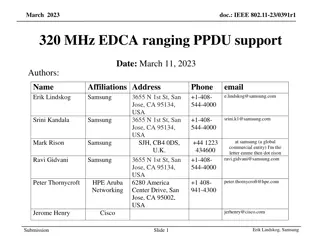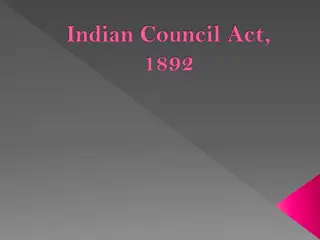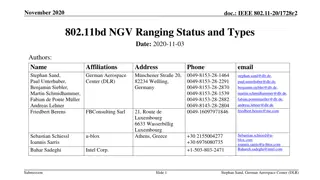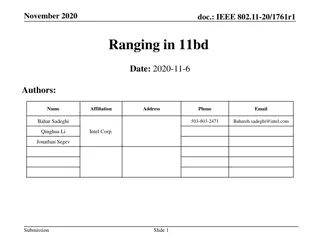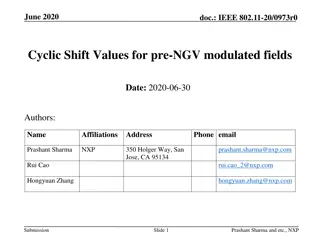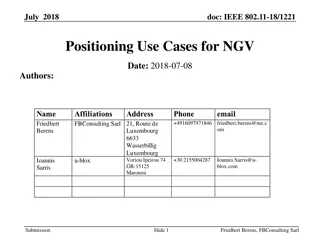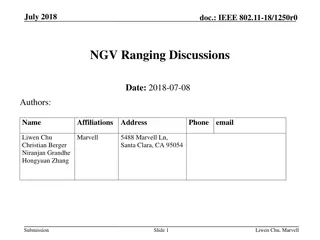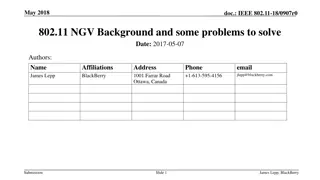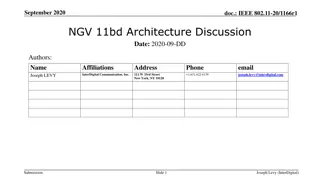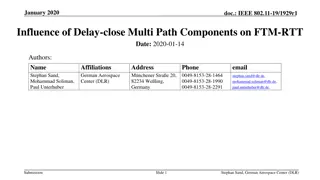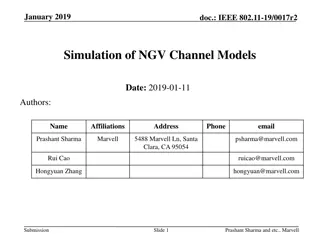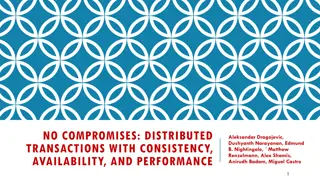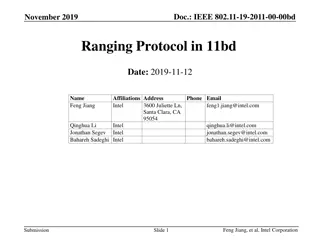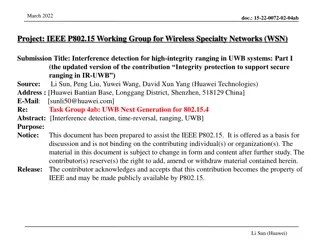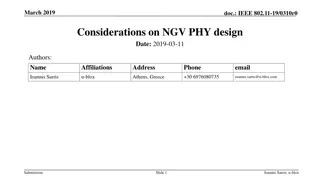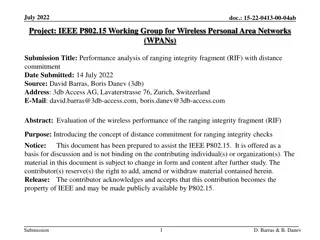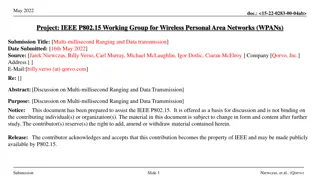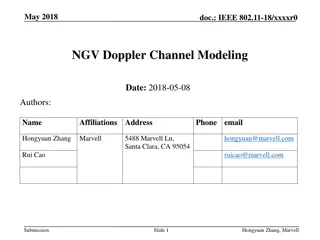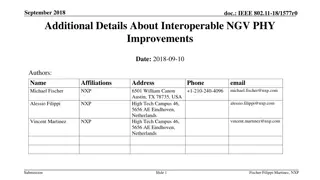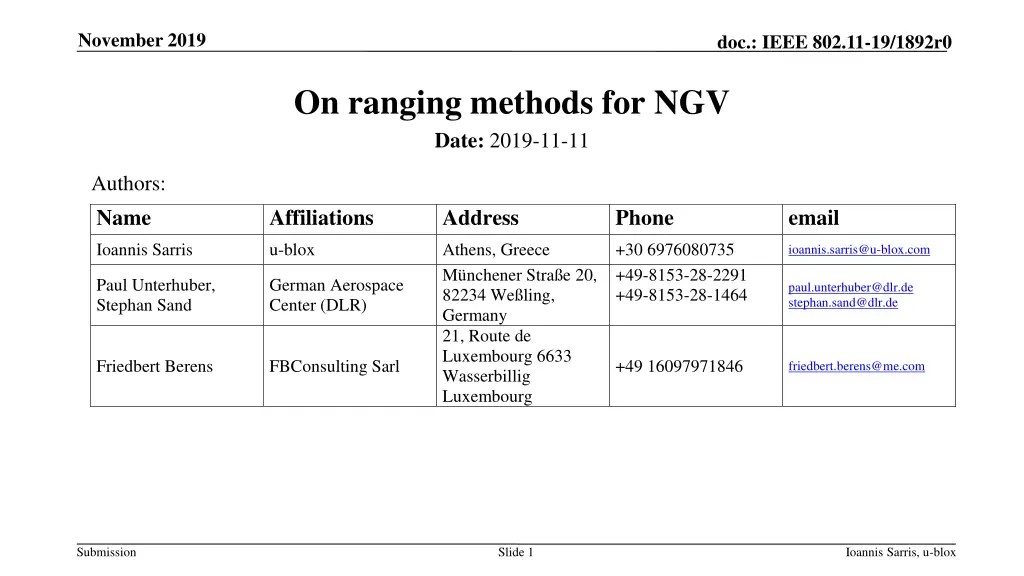
Methods for 1-Dimensional Ranging in IEEE 802.11bd
"Explore different ranging methods for next-generation V2X technology in IEEE 802.11bd, focusing on challenges, strengths, and various techniques like one-way and two-way ranging. Join the high-level discussion on enhancing position estimation for automated driving systems."
Download Presentation

Please find below an Image/Link to download the presentation.
The content on the website is provided AS IS for your information and personal use only. It may not be sold, licensed, or shared on other websites without obtaining consent from the author. If you encounter any issues during the download, it is possible that the publisher has removed the file from their server.
You are allowed to download the files provided on this website for personal or commercial use, subject to the condition that they are used lawfully. All files are the property of their respective owners.
The content on the website is provided AS IS for your information and personal use only. It may not be sold, licensed, or shared on other websites without obtaining consent from the author.
E N D
Presentation Transcript
November 2019 doc.: IEEE 802.11-19/1892r0 On ranging methods for NGV Date: 2019-11-11 Authors: Name Affiliations Address Phone email Ioannis Sarris u-blox Athens, Greece M nchener Stra e 20, 82234 We ling, Germany 21, Route de Luxembourg 6633 Wasserbillig Luxembourg +30 6976080735 +49-8153-28-2291 +49-8153-28-1464 ioannis.sarris@u-blox.com Paul Unterhuber, Stephan Sand German Aerospace Center (DLR) paul.unterhuber@dlr.de stephan.sand@dlr.de Friedbert Berens FBConsulting Sarl +49 16097971846 friedbert.berens@me.com Submission Slide 1 Ioannis Sarris, u-blox
November 2019 doc.: IEEE 802.11-19/1892r0 Abstract This contribution discusses some possibilities for 1-dimensional ranging. The objective is to initiate a discussion on the different methods which may be adopted in 802.11bd. Thus, the presentation is aimed at a high-level brainstorming discussion rather than promoting a specific method into the standard. Submission Slide 2 Ioannis Sarris, u-blox
November 2019 doc.: IEEE 802.11-19/1892r0 Introduction The NGV PAR specifies that this amendment defines procedures for at least one form of positioning in conjunction with V2X communications Identifying positioning methods for V2X is probably outside the scope of a PHY / MAC specification However, 802.11bd may define 1-dimensional ranging methods for enabling or improving the estimation of position at a system level As we move towards automated driving, this capability may be the decisive factor in the success of a next-generation V2X technology Submission Slide 3 Ioannis Sarris, u-blox
November 2019 doc.: IEEE 802.11-19/1892r0 Ranging with 802.11 Various methods already exist and either use proprietary (eg RSSI measurements) or standardized (11v TM / 11mc FTM) technologies There are a few important differences between how these can be applied in the context of 802.11bd (i.e. in V2X scenarios): Challenges High mobility (up to 500 km/h) OCB operation (no central coordination) Narrow bandwidth (commonly 10 MHz compared to up to 160 MHz of .11ac/ax) Duty cycle restrictions combined with large number of nodes Strengths A tightly integrated GNSS is commonly deployed with the V2X modem Submission Slide 4 Ioannis Sarris, u-blox
November 2019 doc.: IEEE 802.11-19/1892r0 Ranging Methods One-way ranging Two-way ranging Fine Timing Measurement Non-Trigger Based ranging Submission Slide 5 Ioannis Sarris, u-blox
November 2019 doc.: IEEE 802.11-19/1892r0 One-way ranging Procedure Device A sends a packet containing information on t0 Measurement method Device B acquires t0 from packet and measures t1 dt0 = t1 t0 Challenges Accurate absolute timing is needed in A & B Exact timing of actual packet transmission (at ns-level) is not scheduled in advance. Inserting this information into the packet is challenging Need to find an appropriate place (PHY? / MAC? / higher layers?) for the t0 information Submission Slide 6 Ioannis Sarris, u-blox
November 2019 doc.: IEEE 802.11-19/1892r0 Two-way ranging Procedure Device A sends a unicast or RTS packet Device B responds with ACK or CTS Measurement method Device A knows t0 and t1 dt1 = 32 us ( 1.3 us*) *10% aSlotTime at 10 MHz dt0 == dt2 dt0 = (t1 t0 32us) / 2 Challenges Tolerance on response timing is too high (390m distance) Accurate relative timing is needed in A & B Only limited to unicast messages Submission Slide 7 Ioannis Sarris, u-blox
November 2019 doc.: IEEE 802.11-19/1892r0 Fine Timing Measurement Propagation delay from round trip time (RTT) ranging measurements: RTT= ?4 ?1 ?3 ?2 2 Time to obtain RTT range ~ 30 ms (minimum 6 messages) Position: 3 ranges needed => 18 messages (90 120 ms) FTM creates high channel load Passive ranging is also possible: Parameters recorded by Observing STA when monitoring FTM message exchange Observer needs in addition to t1 and t4 also TOF = RTT/2. Could be transmitted with Ack Submission Slide 8 Ioannis Sarris, u-blox
November 2019 doc.: IEEE 802.11-19/1892r0 Non-Trigger Based ranging SIFS = 16 s, NDP = 56 s to (44+16*n) s < 1 ms Minimum 4 messages needed Position: 3 ranges needed => 12 messages (3 4 ms) Passive ranging is also possible: Observer needs in addition to t2 and t3 also t1 and t4 Need to be transmitted with additional message Submission Slide 9 Ioannis Sarris, u-blox
November 2019 doc.: IEEE 802.11-19/1892r0 Ranging constrains European regulation (ECC Decision 08/01) defines duty cycle restrictions: Long term: 1% measured over an hour, typical CAM/BSM use in average 0.5% Short term: Up to 3% for a second, used for event-driven messages like DENM Raging operation need to respect these restrictions Communication congestion: ITS communication is restricted by channel congestion Congestion control is required to guarantee proper operation of C-ITS systems All ranging operations have to take that into account Whenever possible ranging operation should be combined with data communication Submission Slide 10 Ioannis Sarris, u-blox
November 2019 doc.: IEEE 802.11-19/1892r0 Conclusion Various 1-dimensional ranging methods already exist for 802.11, however these need to be adapted in order to address the challenges and harness the strengths of V2X Providing support for high-accuracy (dm-level) measurements might be the selling point of 11bd as a next-generation V2X technology Restrictions need to be followed and unnecessary overhead should be avoided. Whenever possible, ranging should come with minimal or no overhead to normal data exchange Submission Slide 11 Ioannis Sarris, u-blox

